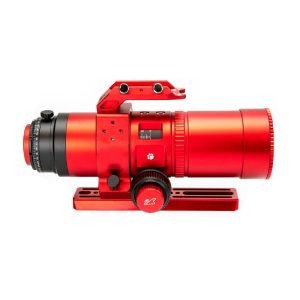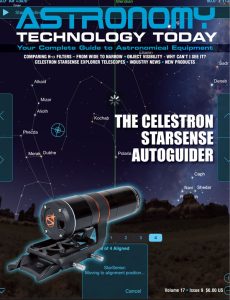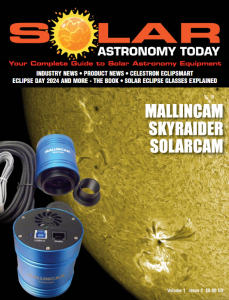The William Optics RedCat 51 III represents the latest update to the venerable RedCat 51, now offering the patented William Optics Internal Focus Design (WIFD).
 With the WIFD design, the movement of the focuser is integrated inside the main tube assembly providing the benefits of a traditional two speed fine focuser, while not worrying about limitations typically found in traditional rear mounted focusers. The WIFD design includes the patented William Optics center focuser with precise internal sliding of fixed optics to prevent image shift. The integrated position viewing window on the focuser provides instant verification of the graduated numerical display.
With the WIFD design, the movement of the focuser is integrated inside the main tube assembly providing the benefits of a traditional two speed fine focuser, while not worrying about limitations typically found in traditional rear mounted focusers. The WIFD design includes the patented William Optics center focuser with precise internal sliding of fixed optics to prevent image shift. The integrated position viewing window on the focuser provides instant verification of the graduated numerical display.
The smooth rack and pinion design is incorporated into the focuser to provide super fine adjustability for critical focus. The internal movement of the optical elements is protected from the elements and can’t come out of alignment. The redistribution of weight allows for better balance during imaging sessions.
Another benefit from this latest version of the RedCat 51 is new motorized focusing functionality as it now offers ZWO EAF compatibility. The focuser has dedicated mounting points for the EAF and similar style electronic focusers, which makes it a straightforward process to motorize the telescope. Other improvements include a more standard focuser tension/ lock adjustment and better cable management.
The William Optics RedCat 51 III offers a 51mm objective lens in a sleek quadruplet Petzval APO design, using Synthetic Fluoride (FPL53 and FPL51) glass for a full frame flat field image.
The RedCat 51 optical tube is held with a single ring that’s sufficiently rigid to hold the tube and a large DSLR without flexure. You can easily rotate the tube with the help of a large locking knob. The tube ring also includes female threads that let you add a red-dot finder, guide camera, microphone rig, or other accessories.
The William Optics RedCat 51 also comes with a range of useful accessories with astronomy imaging in mind. There’s a super-bright Bahtinov mask that makes it a snap to focus the telescope in just a few seconds. Cap the mask with the ‘whiskered cat’ cover, and it serves as a protective cap for the objective lens.
The William Optics RedCat 51 II includes a reversible mounting base for Vixen-style astronomy mounts or an Arca-Swiss mount used in photography tripod heads. A sun-shade/dew-shield keeps stray light out of the telescope, and you can invert the shield and slide it over the objective cell to minimize the length of the tube for transport and storage. And all this is packed into a portable size.
The William Optics RedCat 51 II is ideal for ultra-wide-field imaging of the deep sky and for terrestrial imaging of birds, landscapes, and wildlife. The RedCat 51 focal length is 250mm, which many find to be a sweet spot for wide field astrophotography. The Orion Nebula, Andromeda Galaxy, Heart and Soul Nebulae, North America Nebula, and many more popular regions of the sky easily fit into the field of view.
With premium apochromatic optics in a Petzval design, the RedCat 51 is sharper and better corrected than many lenses of similar focal length. The superb optical design and a fast focal ratio of f/4.9 make this little scope a powerful imaging tool.
With its high-quality synthetic fluorite FPL53 and FPL51 glass in a 4-element, 3-group classic Petzval design users will receive superb color correction and an exceptionally flat field. No field flattener is needed with this scope. The RedCat is engineered to have a big 43mm image circle compatible with APS-C and full-frame DSLRs, mirrorless, and dedicated astronomy cameras. With a camera with a full-frame (36mm x 24mm) sensor, the telescope offers an expansive field of view nearly 10 degrees across the sensor diagonal.
The RedCat 51 is optimized for use as an imaging instrument, but it also makes a superb little scope for visual use. Just add William Optics’ optional 1.25″ erecting prism diagonal made specifically for this scope (sold separately) and your favorite eyepiece, and you’re ready for a night of observing the Milky Way or for a pleasant day of birdwatching. The helical focuser has an attractive finish and engraved calibration markings, and it includes a tension adjustment to increase focusing drag or to lock the focuser in place.
The lens assembly can be moved within the telescope body over 33mm by rotating the focusing collar in the front. The distance from the base of the M48 male thread on the RedCat to the chip plane should be 59.7mm with the lens cell completely retracted at the 0mm position. With the lens cell fully extended to 33mm, the chip-to-thread distance must at least be 59.7 – 33 = 26.7mm. This means the thread-to-chip distance can be anywhere between 26.7mm and 59.7mm to reach focus. This is easily achieved with DSLRs with standard M48 T-rings. Many astroimaging cameras will also reach focus with a standard 2″ M48 threaded nosepiece or with accessories such as filter wheels.
The William Optics RedCat 51 III specifications include:
– Focal Length: 250mm
– Diameter: 51mm
– Aperture: f/4.9
– Image Circle: >43mm
– Tube length (fully retracted): 228mm
– Tube length (fully extended): 291mm
– Dew Shield Circumference: 255mm
– Dew Shield Diameter: 80mm
– Weight: 2.9 lbs./1.3kg (OTA only); 3.9 lbs./1.76 kg (OTA with ring and dovetail)
– Interchangeable T-mounts (sold separately): Canon EF, Nikon F, Sony E, Pentax, Micro Four Thirds, Fuji.
You can learn more about the William Optics RedCat 51 III here.

 And to make it easier for you to get the most extensive news, articles and reviews that are only available in the magazine pages of Astronomy Technology Today, we are offering a 1-year magazine subscription for only $6! Or, for an even better deal, we are offering 2 years for only $9. Click here to get these deals which only will be available for a very limited time. You can also check out a free sample issue here.
And to make it easier for you to get the most extensive news, articles and reviews that are only available in the magazine pages of Astronomy Technology Today, we are offering a 1-year magazine subscription for only $6! Or, for an even better deal, we are offering 2 years for only $9. Click here to get these deals which only will be available for a very limited time. You can also check out a free sample issue here.
The Sun is more active than it’s been in years and if that’s not enough, we have the upcoming Total Solar Eclipse on April 8, 2024! If you’d like to learn more about the technology behind solar observing, solar imaging and more, you can check out our new monthly magazine – Solar Astronomy Today. It’s free to read, no subscription needed and available here. And if you are preparing for the upcoming eclipses and want to know your equipment options from solar glasses to the most out of this world solar viewing and imaging options, check out our free publication – The Definitive Guide to Viewing and Imaging the Sun – simply click here and enjoy reading!

